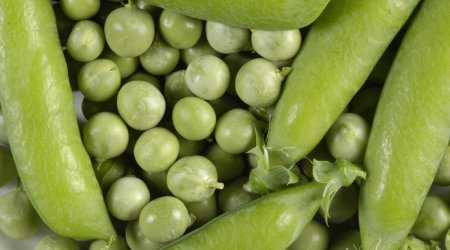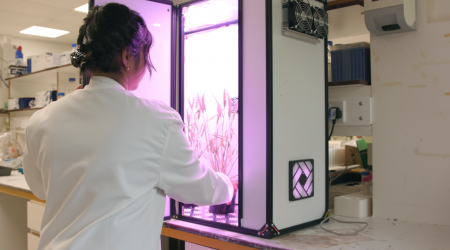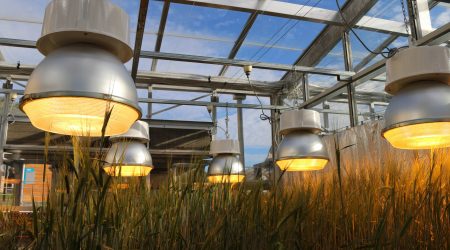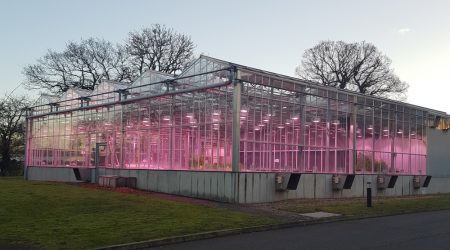A step change in resources available to wheat research over the past decade can now be exploited to increase our understanding of the effect of temperature and drought on this challenging crop.
Wheat is the most widely grown cereal crop on the planet, a staple of the world economy, supplying one fifth of calories consumed by people each day.
Wheat also presents challenges; it is the most genetically complex of all the major crops. Bread wheat Triticum aestivum is a hybrid of three wild grasses, its genes arranged across six copies of chromosomes, five times larger than the human genome. This is in part a legacy of 10,000 years of hybridisation – as growers sought to enhance natural variation for higher, more nutritious yields.
Wheat is the most sensitive to temperature and drought of the three major cereal food crops (rice and maize are the others). With global temperatures predicted to rise throughout this century it has been estimated that for each °C increase, global wheat production will decrease by 6%. An increase in temperature of only 4°C could result in major risks to food security and all the chaos that this has historically brought humanity.
Despite the challenge Professor Graham Moore, programme leader of the UKRI-BBSRC-funded Designing Future Wheat Institute Strategic Programme, is optimistic.
“There has been a step change in resources available to wheat researchers, with Designing Future Wheat either leading or contributing to these advances,” says Professor Moore, a Group Leader at the John Innes Centre. “They include a gold standard wheat genome sequence. Thanks to this we know the gene content of wheat and the order of genes along the chromosomes. We also know the expression of every gene across about 1,200 different tissues, therefore we know where every gene is expressed and what it might interact with.”
Researchers from the Designing Future Wheat programme were among the 200 scientists from 73 research institutions in 20 countries that assembled and annotated the enormous dataset in 2018. It is an example of the collaborative approach that has been the model for these improvements in resources, says Professor Moore.
Other open-source resources include: Wheat Tilling lines, a public database including more than ten million mutant lines; Rapid Gene Cloning, which identifies useful disease resistant genes in the wild relatives of cultivated wheat; Mapping Populations to allow researchers to dissect traits; and Speed Breeding, which has shortened by about one third wheat’s generation time.
These resources – along with state-of-the-art genetic approaches such as gene-editing – mean that wheat can now be worked on directly, while in the past researchers relied on the use of synteny with less complex crops such as rice, and then applying the findings to wheat.
Recent advances on environmental effects, have focused on how high and low temperatures influence meiosis, the reproductive phase of wheat.
Professor Moore’s group study the Ph1 gene, which has been shown to have been involved in stabilising wheat as a polyploid during meiosis. Employing genome editing technology has identified the meiotic gene ZIP4 as being responsible for the Ph1 phenotype.
Polyploidy is an important phenomenon in flowering plants where two species cross, but their cells do not re-divide, creating instead a hybrid with double the chromosome numbers, effectively creating a plant within a plant. It leads to larger plants – and yields – hence its association with crops, but it also makes its sexual reproduction phase more susceptible to temperature changes.
A recent study involving Professor Moore’s group showed that high temperatures (above 30°C) during pre-meiosis – the start of the sexual reproduction cycle – prevented normal progression, reduced grain number and pinpointed the effect to chromosome 5D on the wheat genome. This has led to further research looking for wheat varieties with heat-tolerant genes which can be used to develop new cultivars better adapted to predicted temperature increases.
A second study, a collaboration between the John Innes Centre and the University of Cordoba, Spain, published in 2019, takes forward the work on temperature effects on wheat, defining Dmc1 as a candidate gene for temperature tolerance during meiosis.
Dmc1 – also on chromosome 5D – is identified as stabilising normal chromosome crossover in both low temperatures (below 13°C) and high temperatures (above 30°C). Identifying such candidate genes that can stabilise chromosome pairing against extremes of temperature may allow breeders to exploit this to select wheat genotypes with variants of this gene that confer better low and high temperature tolerance.
A neat twist was added to the tale by an unrelated study which showed that the Japanese fire belly newt during winter doesn’t have a productive phase until temperatures go above 13°C and that the temperature effect is related to Dmc1, the same gene identified in wheat.
New approaches are the key to unlocking the genetic potential of heritage varieties which may contain temperature and drought-tolerant variation.
– Professor Graham Moore
“Dr Simon Griffiths, my colleague, has crossed and developed from these old varieties of wheat which go back over the last century, mapping populations in which there may be opportunities to identify lines exhibiting increased temperature tolerance. “The new genomic tools which are available make it much easier to understand and to categorise these collections. The Watkins is just one collection but there are other collections around. It’s not just old landraces – many of the wild relatives of wheat have interesting phenotypes too.”
Designing Future Wheat has provided a collaborative model of shared resources and has either led or contributed to the step changes we have seen in wheat research, says Professor Moore. Much of the focus of global wheat research has been on coaxing higher yields out of wheat – with increases in grain weight now possible thanks to advances in the genetics of seed size and number. But the urgency of climate crisis has led to an emerging priority.
“Many of the areas where wheat is growing will be significantly affected by climate changes. Our first focus was yield but now it has moved to heat and drought,” says Professor Moore. A combination of new techniques, old varieties and perhaps even a species of Japanese newt will figure in the unpredictable, unfolding story of wheat.









